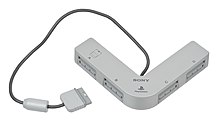Multitap
While historically strong, the demand for console-specific multitaps had largely vanished over the course of the seventh generation, where it became much more common for controllers to connect either wirelessly (removing the need for physical controller ports altogether) or through standard USB ports (allowing a USB hub to serve the same function as a multitap).
The earliest multi-controller adapter was the Joypair by HAL Laboratory, released in Japan for Nintendo's Family Computer in 1985, which allows two additional controllers to be plugged into the console's DA-15 expansion port.
Originally the Joypair was only intended to allow two players to use specialized controllers (specifically HAL's Joyball [ja] controllers) in place of the standard Famicom joypads (which were hardwired into the console itself), but Nekketsu Kōkō Dodgeball Bu (the Japanese version of Super Dodge Ball) utilized it to allow up to four players to participate in the game's Bean Ball mode.
The Multitap (the first device to be marketed with such a name) by NEC Home Electronics for the PC Engine, which launched alongside the platform in Japan on October 30, 1987, was the first multi-controller adapter made specifically for multiplayer support, allowing up to five controllers to be plugged into the console.
As a result, various inexpensive alternatives to the Multitap were released for the PC Engine by third-party companies, such as the Battle Tap by Big Club and the Joy Tap 3 by Hudson Soft, which featured less controller ports than the first-party Multitap, but these were gradually phased out as more games started to allow up to five players.
One particular unlicensed model, the Tribal Tap 6 Player Adaptor by Naki, added a fraudulent sixth controller port that was promoted as a selling point against competing multitap models, even though no licensed SNES game ever supported more than five players and the sixth racer of Battle Cross is always controlled by the computer.
The 4-Way Play (which utilized both controller ports) was developed by Electronic Arts without license from Sega and was made specifically for their lineup of sports games (such as Madden NFL '94), whereas the Team Player (known as the SegaTap in Japan) was developed by Tengen for Gauntlet IV and sold by Sega as a first-party product.
In contrast to the 4-Way Play, the Team Player only required one controller port (leaving an additional port free for a fifth player, much like the Super Multitap) and also acted as a splitter that allowed users to switch between multiple input devices (such as a mouse or a light gun) connected to the console at the same time.
Instructions for how to build a multitap were included in the manual to classic Amiga racing sequel Super Skidmarks.
Earlier, the Amiga version of Bomberman, Dynablaster had already included support for a similar device, as demonstrated on Season 2, Episode 5 of TV's GamesMaster.
[6] A six-controller adapter was released for the Sega Saturn (sold as the Multi-Player Adaptor in the United States and as the Multi Terminal 6 in Japan), which features the most controller ports out of all the multitaps made by first party manufacturers.
Dreamcast and the original Xbox would follow the N64's example by including four controller ports as default as well, as did Nintendo's succeeding console, the GameCube.




